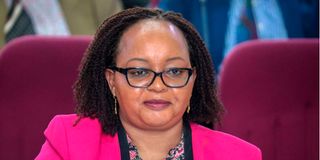Waiguru to climate forum: Kenyan women drowning in sewage and floods

Kirinyaga Governor Anne Waiguru on November 28, 2023. At the ongoing COP28 in Dubai, UAE, she has shed light on the plight of Kenyan women and children, including some drowning in sewage and El Nino floods.
What you need to know:
- Ms Waiguru, the governor of Kirinyaga, says the predicament is the reason she is happy with the launch of a Sh5 billion fund with an incentive that supports women in climate-resilient projects.
- Last week, Nairobians living in riparian and flood-prone areas appealed to the government to find them alternative accommodation after the Nairobi River burst its banks, sweeping all manner of filth into their houses.
At the ongoing 28th Conference of the Parties (COP28) in Dubai, UAE, Council of Governors (CoG) chairperson Anne Waiguru has shed light on the plight of Kenyan women and children in the face of climate change, saying some drown in sewage and El Nino floods.
Ms Waiguru, the governor of Kirinyaga County, says the predicament is the reason she is happy with the launch of a Sh5 billion fund, by the African Development Bank, which has an incentive that supports women to undertake climate-resilient projects.
Last week, Kenyans living on riparian land and in flood-prone areas in Nairobi’s Soweto and Kibra appealed to the national and county governments to find them alternative accommodation after the Nairobi River burst its banks, sweeping all manner of filth into their houses.
Ms Waiguru told the world that Kenyan women and children are bearing the brunt of the climate crisis, as it has decimated their livelihoods and strained healthcare systems at a time when the country is not doing well on resources. She urged leaders to desist from disregarding information from early warning systems and authorities such as the Kenya Meteorological Department.
“The needs far outweigh the resources that we have, but Kenya is one of those countries that have taken the initiative at the county level to set up a fund known as the County Climate Change Fund. It has been passed by most of the county governments and requires that out of all the development money we receive from the exchequer, at least one to three per cent go to efforts related to climate change, either mitigation, capacity building, or adaptation for communities, but, still, it’s not enough.”
The governor attended a panel discussion themed ‘Finance fit for Change: Co-designing multi-level mechanisms to unlock flows of climate finance to subnational level’. “One to three per cent of a development budget of a billion shillings is about Sh10 million and doesn’t even touch an inch of what communities require,” she later told Nation.Africa in an interview.
“Look at the damage caused by the current floods, which are a result of the climate crisis. If you can remember, previously, we had drought. But just when we were recovering from the impacts of that drought, now we have extreme weather again, meaning that money will not be enough even to replace the livestock our affected counties in northern Kenya have lost, for example.
“For Kirinyaga, we need resources to restore land and rivers that have been degraded by floods,” she told delegates, stressing the need to strengthen capacity of subnational governments to plan, track and implement climate-resilient projects in agriculture, infrastructure, water and environment by climate-proofing investments and cushioning communities from climate shocks and stressors.
Highlighting how Kenyan counties are navigating the climate crisis, she cited the Successful Design of the Financing Locally Led Climate Action commonly known as FLLOCA Programme.
“During the design stages of the FLLOCA Programme, Kenya adopted an inter-agency approach involving key stakeholders, that is the National Treasury and Planning, the Climate Change Directorate, the Council of Governors, county governments, to spearhead efforts to improve local climate action as per their respective mandates as prescribed in the National Climate Change Action Plan. This has improved the capacity of subnational governments to tackle climate change effects through knowledge transfer and facilitation.”
According to Ms Waiguru, piloting of the County Climate Change Fund was undertaken between 2011 and 2018 by the Adaptation Consortium in arid and semi-arid counties of Garissa, Isiolo, Kitui, Makueni, and Wajir, where the financial and governance structures for climate actions were designed, demonstrated, and strengthened while ensuring that local communities were central to decision-making on resilience building and adaptation investments.
She further urged the private sector to be fully involved in the climate conversation to elevate things like livestock insurance.
“The private sector will have a business bias to align with central government as opposed to the counties where they may not stand to leverage much comparatively. This has been the case even where mitigation functions in cross-cutting sectors are devolved, so we have increasingly advocated a one-government approach,” she told delegates in Dubai.
“While livestock insurance can be a valuable tool for climate mitigation, it is important to address challenges such as affordability, accessibility, and the need for accurate climate data. Additionally, comprehensive strategies that combine insurance with other climate adaptation and mitigation measures will be most effective in building resilient agricultural systems in the wake of climate change.”





